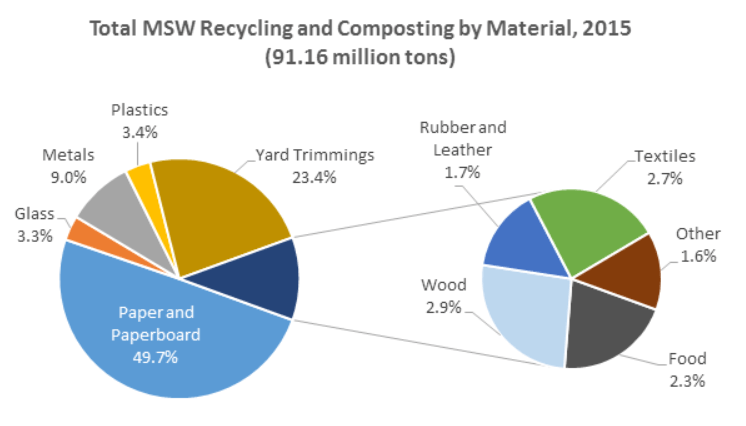This just in: Americans only recycle 34 percent of discarded materials. While this number is up dramatically from only 6 percent in 1960, the U.S. still falls behind other developed countries. Germany currently leads the world race in recycling municipal solid waste with a whopping 68 percent recycling rate, and countries like Austria, South Korea, Wales, and Switzerland round out the top 5. As of 2019, the United States has yet to touch the top 10 recycling countries list.
The U.S. is Making Strides, But Still Lagging
While there is definite room for improvement in the U.S., it is worth noting that Americans are no longer creating more trash per capita than other countries around the world. In addition, MSW recycling rates from 1960 to 2015 show the amount of waste being recycled has increased year over year. According to the most recent EPA survey, the total materials recycled in 2015 reached nearly 68 million tons (with 23.4 million tons being composted).
Of that 68 million tons of recycled MSW, 50 percent was paper and paperboard, 3 percent was plastic, 9 percent was metal, and 3 percent was glass, plastic, and wood. You probably noticed: plastics are recycled at a drastically low rate in the U.S.

While LED light bulbs, energy-efficient vehicles, community gardens, and e-waste donation centers all seem to be booming across the country, how is the U.S. stepping up its recycling game? By addressing the weakest links in its system.
Sorting Plastics Waste
The most critical issue in the United States is the sorting and management of discarded plastic. In order to resolve this issue, the public needs to be informed on how to sort and recycle materials.
Germany, the world leader in recycling, has a very clear sorting system: any kind of bottle or glass jar belongs in the designated glass bins. Glass is sorted by color and in their bins, there are different slots for depositing green, brown and clear glass. In each municipality, you’ll see other colored bins — green, blue, yellow, brown, and gray. While each municipality has its own color system, it is well established and advertised so people know how to sort their recyclable waste.
American recycling resources—properly labeled bins, pick-up locations, etc.—need to be established and be accessible just like Germany. Ideally, that looks like recycling receptacles being placed and clearly labeled at people’s homes, in public spaces, and on construction and demolition sites. Recycling bins need standardized labels that are obvious, clear, and easily understood. Sustainable waste management companies need to be created. Existing companies, such as General Kinematics, help make recycling more efficient through advancements in technology and design. Another component of improving recycling in the United States is addressing C&D waste.
Managing C&D Waste
Countries like Germany and Austria, who lead the recycling race, have had C&D waste management in place for several decades.
Austria, which has led the recycling race until the last 3 years, has C&D initiatives that exist on the state and local level. For instance, the city of Vienna created a guideline to reduce C&D waste. Across the country, C&D waste is collected and recovered by smaller or mid-sized companies (10-50 employees), of which 80 percent are members of the Austrian Association for Recycling of Building Materials. In the U.S., the EPA promotes sustainable materials management and the CDRA (Construction & Demolition Recycling Association) is hard at work to promote C&D recycling throughout America. GK is a proud supporter of the CDRA and its members as they continue to work hard to institute better environmental practices in the U.S.
What are the top obstacles that prevent successful C&D waste management? In 2015, soft federal regulations were among the top issues reported in Austria CDW management. Other challenges include heterogeneous quality of materials, lack of economic incentives, and speculation regarding the end-of-life status for materials that need to meet strict standards.
Austria has successfully progressed its C&D waste practices through developing a well-established network, strong legal framework, collaborations between industry and policymakers, an establishment of quality norms, and enforcement. In likewise effort, US C&D recyclers are working hard to increase recycling within this waste stream, too.
The Forecast
The EPA has declared that they are thinking beyond waste, and actively brainstorming a systematic approach that will provide a transition from waste management to sustainable materials management (SMM).
Recycle Across America reports that when U.S. recycling levels reach 75 percent, it will be the environmental and CO2 equivalent of discarding 55 million vehicles from the roads each year, plus an accumulation of 1.5 million new jobs across the country.
General Kinematics has been innovating recycling equipment to improve separation processes for decades. Talk to a GK engineer today to learn how you can advance your separation processes.






